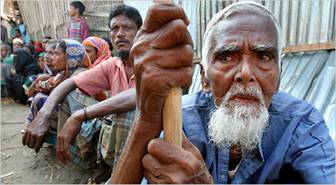|
Bangladesh Toll at More Than 3,000
By Graham Bowley, The New York Times
Bangladesh
November 20, 2007

People waited for relief goods on Monday in the village of Maithachomohoni in the southern coastal area of Bangladesh.
The number of people left dead after the powerful cyclone that swept through Bangladesh last Thursday rose to more than 3,000 today, the government said, and the United Nations estimated that a million people had been left homeless, many of them in remote areas without predictable food supplies.
The Bangladesh Red Crescent had warned Sunday that the number of dead could conceivably be between 5,000 and 10,000, and the United Nations World Food Program today said it would not be surprised by such a tally. But today the International Federation of Red Cross and Red Crescent Societies said that reports from its officials who had been to the most affected areas led the organization to expect that the final toll would be in line with the government’s official assessment.
“What we are seeing on the ground is not as horrifying,” said Devendra Tak, a senior regional spokesman for the federation, who spoke from Khulna, a town in southern Bangladesh, after visiting some of the worst affected districts the furious cyclone had struck last week with winds of over 100 miles an hour. “We don’t see the level of destruction that we had feared earlier.”
Mr. Tak said thousands of fishermen who had been missing along the coastal areas and presumed dead had begun to turn up in their villages. “We are very optimistic that the overall disaster will not be on a very high level,” Mr. Tak said by telephone.
The United Nations said that they were waiting for a fuller picture to emerge and that the final death toll could still be significantly higher. Usha Mishra, a senior adviser at the United Nations World Food Program, said that food supplies had been severely disrupted, and that there was risk of famine.
She said the program had begun to distribute some food, including high energy biscuits. But she said more serious emergency operations were being considered, including broader food distribution and rebuilding of homes. “Shelter is the big need right now,” she said. “One million people have been turned homeless.”
She said the cyclone had devastated farming land that had already been severely damaged by earlier flooding in August.
“We do face a prospect of some remote areas not getting some” supplies, she said. “We might see starvation in some areas.”
The government’s officially confirmed death toll from the cyclone reached 3,113, said Lt. Col. Main Ullah Chowdhury, a spokesman of the army, according to The Associated Press.
He said reports were finally reaching the capital, Dhaka, from the areas that had been affected by the storms and that had been isolated because roads had been washed out and telephone lines had been knocked down, the A.P. reported.
Even if the death toll rises as some expect, it will still likely be relatively low by the standards of Bangladesh, a poor country that has long been vulnerable to natural calamity.
In 1991, a tropical storm claimed roughly 140,000 lives. Bangladeshi relief agencies have since built early warning systems and thousands of storm shelters to help people evacuate before disaster strikes.Mr. Tak said much of the fury of the cyclone had been dissipated over the region’s extensive forests before it struck more inhabited areas.
He said the systematic distribution of aid had begun on Sunday and continued today, and that the cyclone preparedness program and urgings that people leave their homes for the cyclone shelters had saved many lives.
“It could have been better except some people are very hard to convince,” he said.
He said 200,000 people had been evacuated from their homes in the district around Khulna alone, and many more had been moved from their homes in the broader
region.
He said the government had done a “good job” in providing first aid and counting the dead. The relief and rehabilitation efforts are an important test for the country’s army-backed caretaker government.
The leader of the interim government, Fakhruddin Ahmed, flew to the devastated regions today, Reuters reported. “Your courage in facing the disasters like cyclones and floods give us strength and reinforce confidence in our ability to do the best we can,” he said in Patuakhali, one of the badly hit districts, Reuters reported.
More
Information on Rural Aging Issues in the World
More
Information on Rural Aging Issues in the US
Copyright © Global Action on Aging
Terms of Use |
Privacy Policy | Contact
Us
|



